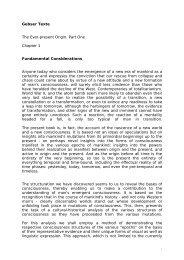The Mass Psychology of Misery - michaeljgoodnight.com
The Mass Psychology of Misery - michaeljgoodnight.com
The Mass Psychology of Misery - michaeljgoodnight.com
You also want an ePaper? Increase the reach of your titles
YUMPU automatically turns print PDFs into web optimized ePapers that Google loves.
with the work <strong>of</strong> Elton Mayo and others, at a time when the promotion <strong>of</strong> consumptionas a way <strong>of</strong> life came to be seen as itself a means <strong>of</strong> easing unrest, collective andindividual. And by the end <strong>of</strong> the 1930s, industrial psychology had "already developedmany <strong>of</strong> the central innovations which now characterize <strong>com</strong>munity psychology,"according to Diana Ralph's Work and Madness (1983), such as mass psychologicaltesting, the mental health team, auxiliary non-pr<strong>of</strong>essional counselors, family andout-patient therapy, and psychiatric counseling to businesses.<strong>The</strong> million-plus men rejected by the armed forces during World War II for "mentalunfitness" and the steady rise. observable since the mid-'50s, in stress-relatedillnesses, called attention to the immensely crippling nature <strong>of</strong> modern industrialalienation. Government funding was called for, and was provided by the 1963 federalCommunity Mental Health Center legislation. Armed with the relatively newtranquilizing drugs to anaesthetize the poor as well as the unemployed, a statepresence was initiated in urban areas hitherto beyond the reach <strong>of</strong> the therapeuticethos. Small wonder that some black militants saw the new mental health services asbasically refined police pacification and surveillance systems for the ghettos. <strong>The</strong>concerns <strong>of</strong> the dominant order, ever anxious about the masses, are chiefly served,however, here as elsewhere, by the strength <strong>of</strong> the image <strong>of</strong> what science has shownto be normal, healthy, and productive. Authority's best friend is relentless selfinspectionaccording to the ruling canons <strong>of</strong> repressive normalcy in the PsychologicalSociety.<strong>The</strong> nuclear family once provided the psychic underpinning <strong>of</strong> what Norman O.Brown called "the nightmare <strong>of</strong> infinitely expanding technological progress." Thoughtby some to be a bastion against the outer world, it has always served astransmission belt for the reigning ideology, more specifically as the place in which theinteriorizing psychology <strong>of</strong> women is produced, the social and economic exploitation<strong>of</strong> women is legitimated and the artificial scarcity <strong>of</strong> sexuality is guarded.Meanwhile, the state's concern with delinquent, uneducable and unsocializablechildren, as studied by Donzelot and others, is but one aspect <strong>of</strong> its overshadowing<strong>of</strong> the family. Behind the medicalized image <strong>of</strong> the good, the state advances and thefamily steadily loses its functions. Rothbaum and Weisz, in Child Psychopathologyand the Quest for Control (1989), discuss the very rapid rise <strong>of</strong> their subject whileCastel, Castel and Lovell's earlier <strong>The</strong> Psychiatric Society (1982) could glimpse thenearing day when childhood will be totally regimented by medicine and psychology.Some facets <strong>of</strong> this trend are no longer in the realm <strong>of</strong> conjecture; James R.Schiffman, for instance, wrote <strong>of</strong> one by-product <strong>of</strong> the battered family in his "Teen-Agers End Up in Psychiatric Hospitals in Alarming Numbers" (Wall Street Journal,Feb. 3, 1989).<strong>The</strong>rapy is a key ritual <strong>of</strong> our prevailing psychological religion and a vigorouslygrowing one. <strong>The</strong> American Psychiatric Association's membership jumped from27,355 in 1983 to 36,223 by the end <strong>of</strong> the '80s, and in 1989 a record 22 millionvisited psychiatrists or other therapists covered to at least some extent by healthinsurance plans. Considering that only a small minority <strong>of</strong> those who practice theestimated 500 varieties <strong>of</strong> psychotherapy are psychiatrists or otherwise healthinsurance-recognized, even these figures do not capture the magnitude <strong>of</strong> therapy'sshadow world.
















